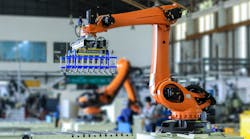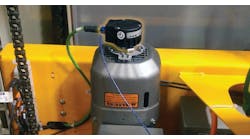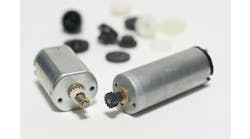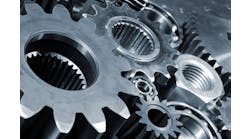Look beyond the buzzwords. Augmented reality (AR) and artificial intelligence (AI) are familiar industrial terms. Augmented reality aims to use technology to enhance the interaction between human and machine, while artificial intelligence applies technology to expedite the ability to create control algorithms.
Both of these approaches to automation have a lot of visibility at trade shows and expositions. Manufacturers are spending a lot of money and resources on making these technologies work for the end user. Behind the bright lights and fancy user devices, manufacturers have also been busy making machines easier to design and program. With the enhancement of the user experience, vendors can now make their machines more intelligent without making the user interaction more complex. One key element in these super-charged machines is the increased use of servo-controlled devices.
Traditional control systems on a repetitive-motion machine would rely on a central drive shaft with cam-driven accessories that perform patterned movement based on the position of the main cycle shaft.
The great thing about these early designs is the calculated behavior of the various accessory devices. Depending on the shape of the lobe on the cam, the device travels the same path every time the drive shaft makes a cycle.
An example of this type of machine would be a horizontal packaging machine. This machine takes a roll of paper or plastic membrane, converts it into a pouch, fills that pouch with product, seals the pouch and then discharges the pouch to further processing. A number of stations are defined on the machine that perform specific functions.
Each of these stations has an accessory that uses a cam mounted on a main cycle shaft that runs the length of the machine. Since each station/accessory moves relative to that central shaft, each motion is coordinated in such a fashion that adjacent stations can work in close proximity to each other.
The upside of this type of system is the secondary devices are always in position relative to the main cycle shaft. In most cases, the cycle shaft can be rotated in either direction while the accessory devices will remain in time, based on the cam relationship to the main shaft.
This is also the downside of this type of system as all functions are lock-step with the cycle shaft. If something goes wrong in the process, the machine must complete the rest of the machine cycle before the cam-driven devices return to their home position.
Another detraction from the physical cam system is speed. The cammed device depends on springs to hold the device against the cam. At high speeds, the device will tend to leave the surface of the cam due to centrifugal force, making the action of the station erratic.
With the advent of servo positioning, it became possible to operate each accessory station, independent of the main cycle shaft, through the use of accurate feedback and precision motor control. The control philosophy remains the same in that the secondary accessories, or axes, still follow the position of the main cycle shaft but without the physical contact of the cam lobe on the cycle shaft. All of this means a significant increase in speed and accuracy.
Additionally, recovery from a sudden stop can be handled in multiple ways. Slave axes can be individually recovered to match the position of the master axis, either prior to or during restart. By uncoupling the various stations on a machine from the master axis, not every station requires an adjustment during a restart; only the parts of the machine that are out of position will need to.
Servos give additional capabilities by allowing for changes in cam profile without having to physically change out a cam to a different profile. Electronic camming means nearly infinite profile possibilities.
On a packaging machine, for example, different package sizes will require different motion profiles to accomplish similar tasks. A large carton, with larger flaps, will need the tucking devices to move in different arcs with slight variances in timing relative to the master axis. This can easily be done by loading a different cam profile for each product as part of a recipe change.
To the end user, all of this is seamless and happens behind the scenes as they select the product from a list and the recipe is loaded into the machine.
On the design side of things, the use of servos usually means a lot fewer moving parts. On a more traditional machine, the main cycle shaft must be driven by a significantly larger motor because it is responsible for moving all of the various assemblies for the entire machine.
By using a servo and decoupling the assemblies, not only is the main motive force greatly reduced, the various assemblies can be driven by smaller motors that only have to be big enough to drive the attached components.
The draw of many slave axes makes the physical design more compartmentalized but can also quickly add up on the controls side of the equation. Each slave axis needs its own servo drive, and the programmable controller has to be sized accordingly. Servo drives communicate via a network, and there are limitations as far as how many connected devices can be on each communications network.
The limitations have to do with the amount of information being transferred between master and slave and how those blocks of information constantly being transmitted and received will affect the performance of the devices themselves. Accurate motion definitely depends on rapidly confirming the relationship between commanded position and actual position.
On the software side, each servo drive is added to a hardware tree in the development environment. The software automatically creates unique tags for each drive and will notify the programmer if more axes are added than the processor is capable of controlling.
For this reason, it is a good idea to create the software version of the control application before finishing the actual control circuit design to make sure that the appropriate processor size is chosen early in the design process.
On the hardware side, servo systems have evolved greatly in the past few years. Not long ago, there was one servo drive for each servo motor. Connections to each motor required power, encoder feedback and sometimes brake cables. Each of those cables had to be routed from the enclosure to the motor on the machine.
On a multi-axis machine, that is an awful lot of cables to manage and might be a significant reason why a pneumatic device might be used in place of a servo, even if it is less accurate to do so. One recent trend is single-cable technology where power, feedback and brake are combined into a single cable from drive to motor. The benefits of routing a single cable versus two or three is obvious.
Another emerging trend is multiple axes in a single drive package. This technology significantly reduces the impact on the footprint in an enclosure. Two axes driven from a drive with the same footprint as a single-axis version can help greatly where footprint is an issue. Additionally, a common incoming power and protection circuit reduces that part of the circuit, as well.
An important thing to consider when using this technology is the failure of one axis in the drive package means two axes are down as a result. Dual-axis drives will also cost a bit more, so, while we are saving room in the panel, the cost of replacement will be higher for the end user.
Yet another trend in servo technology is to put the drive in the motor. With this approach, servos can be daisy-chained for connections, as a single cable can be used for power and network, and each drive/motor becomes a node on the network. All the smarts are in the drive/motor device and communicate on the same trunk back to the programmable controller in the main panel. This technology can be likened to devices on a CANbus, but we are talking about more than just a sensor.
The advantages to these constantly improving technologies are making machine footprints more compact, controls packages smaller, more efficient and, as a result, easier to deploy and duplicate. Machine vendors are more likely to use servos in their control designs with the end user being the ultimate winner—faster processes producing widgets of a higher quality with more flexibility to alter the machine function down the road as trends and desired outcomes change.
The pushback to using new technology is always about the learning curve involved in taking the new gadget and incorporating it into our design. It is human nature to resist change, and we can come up with a million reasons why we can’t or don’t need to accept change. At some point in the journey, we either accept that change or we are forced to do so when our usual way of doing things is no longer available to us.
The trick is to navigate this path in such a way to stay on the leading edge of technology without having to reinvent the wheel. Happily, hardware vendors are making this task easier for us to do, and the results are well worth pursuing.





